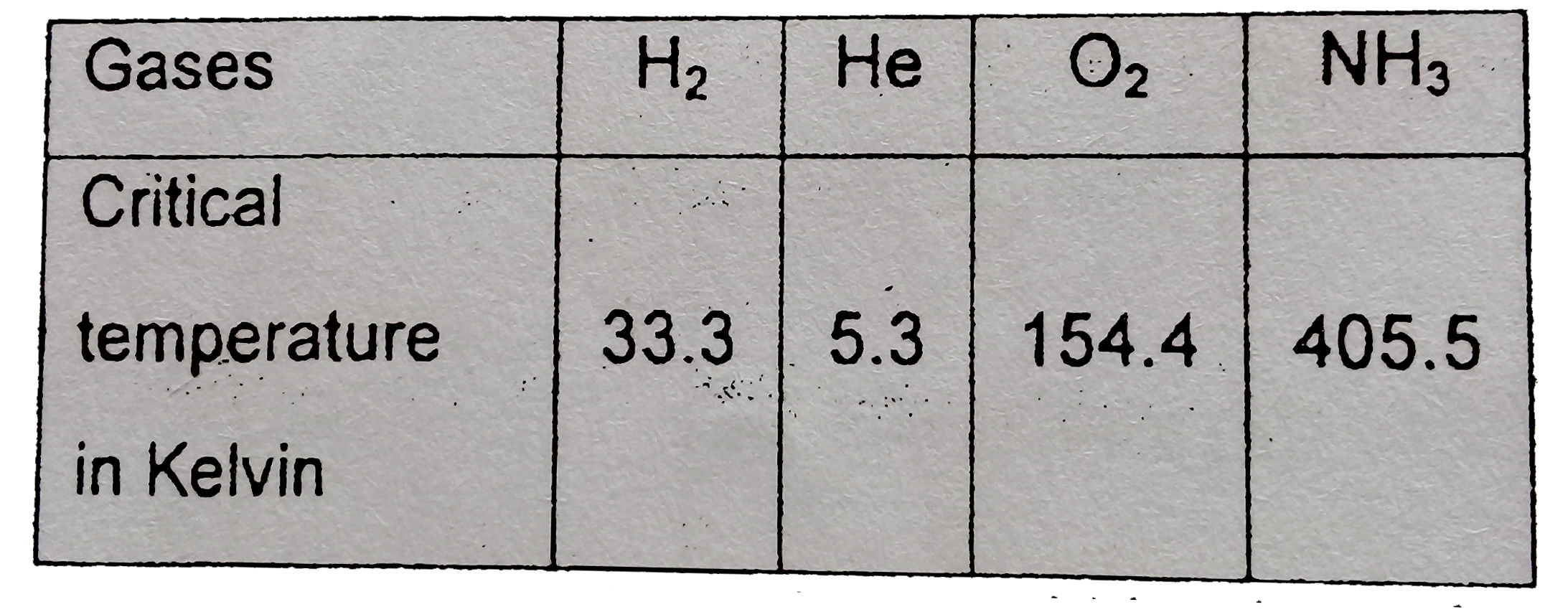Gases possess characteristic critical temperature which depends upon the magnitude of intermolecualr forces between the gas particles, critical temperatures of ammonia and carbon dioxide are 405.5 K and 304.10 K respectively. Which of these gases will liquefy first when you start cooling from 500 K to their critical temperature ?
NH3
CO2
both
none
The correct Answer is:NH3
To determine which gas will liquefy first when cooling from 500 K to their respective critical temperatures, we need to analyze the critical temperatures of both gases and their cooling process.
1. Identify the Critical Temperatures:
- The critical temperature of ammonia (NH₃) is 405.5 K.
- The critical temperature of carbon dioxide (CO₂) is 304.10 K.
2. Determine the Cooling Range:
- We start cooling from 500 K.
- We need to find out how far we need to cool each gas to reach its critical temperature.
3. Calculate the Temperature Difference for Each Gas:
- For ammonia (NH₃):
Cooling required=500K−405.5K=94.5K
- For carbon dioxide (CO₂):
Cooling required=500K−304.1K=195.9K
4. Compare the Cooling Requirements:
- Ammonia requires a cooling of 94.5 K to reach its critical temperature.
- Carbon dioxide requires a cooling of 195.9 K to reach its critical temperature.
5. Conclusion:
- Since ammonia requires less cooling (94.5 K) compared to carbon dioxide (195.9 K), ammonia will liquefy first when cooling from 500 K.
Final Answer:
Ammonia (NH₃) will liquefy first when cooling from 500 K to their critical temperatures.
---
- The critical temperature of ammonia (NH₃) is 405.5 K.
- The critical temperature of carbon dioxide (CO₂) is 304.10 K.
- We start cooling from 500 K.
- We need to find out how far we need to cool each gas to reach its critical temperature.
- For ammonia (NH₃):
Cooling required=500K−405.5K=94.5K
- For carbon dioxide (CO₂):
Cooling required=500K−304.1K=195.9K
- Ammonia requires a cooling of 94.5 K to reach its critical temperature.
- Carbon dioxide requires a cooling of 195.9 K to reach its critical temperature.
- Since ammonia requires less cooling (94.5 K) compared to carbon dioxide (195.9 K), ammonia will liquefy first when cooling from 500 K.
Ammonia (NH₃) will liquefy first when cooling from 500 K to their critical temperatures.
Topper's Solved these Questions
- STATES OF MATTERBOOK - AAKASH INSTITUTECHAPTER - STATES OF MATTEREXERCISE - ASSIGNMENT (SECTION-A)
47 Videos
- STATES OF MATTERBOOK - AAKASH INSTITUTECHAPTER - STATES OF MATTEREXERCISE - ASSIGNMENT (SECTION-B)
32 Videos
- STATES OF MATTERBOOK - AAKASH INSTITUTECHAPTER - STATES OF MATTEREXERCISE - EXERCISE
38 Videos
- SOME BASIC CONCEPTS OF CHEMISTRY BOOK - AAKASH INSTITUTECHAPTER - SOME BASIC CONCEPTS OF CHEMISTRY EXERCISE - ASSIGNMENT SECTION J (Aakash Challenges Questions)
10 Videos
- STRUCTURE OF ATOMBOOK - AAKASH INSTITUTECHAPTER - STRUCTURE OF ATOMEXERCISE - ASSIGNMENT (SECTION -D) Assertion-Reason Type Questions
15 Videos
Similar Questions
Critical temperature of ammonia and carbon dioxide are 405.5 K and 304.10 K respectively. Which of these gases will liquefy first when you start cooling from 500 K to their critical temperature?
View SolutionGases possess characteristic critical temperature which depends upon the magnitude of intermolecular forces between the gas particles. Critical temperatures of ammonia and carbon dioxide are 405.5 K and 304.10 K respectively. Which of these gases will liquify first when you start cooling from 500 K to their critical temperature ?
View Solution
Knowledge Check

Gases possess characteristic critical temperature which depends upon the magnitude of intermolecular forces between the particles. Following are the critical tempeatures of some gases. From the above data what would be the order of liquefaction of these gases? Start writing the order from the gas liquefying first.AHe,H2,O2,NH3BNH3,O2,H2,HeCNH3,He,O2,H2Dnone of theseAssertion :- On cooling ,ammonia lirquifies first whereas CO2 requires more cooling.
Reason :- Critical temperatures of ammonia and carbon dioxide are 405.5 K and 304.10 K respectively.AABBCCDDThe critical temperature and reduced temperature of a gas are 150 K and 3 K respectively. What is the temperature of the gas ?
A50 KB147 KC153 KD450 K
Gases possess characteristic critical temperature which depends upon the magnitude of intermolecular forces between the gas particles. Critical temperatures of ammonia and carbon dioxide are 405.5 K and 304.10 K respectively. Which of these gases will liquify first when you start cooling from 500 K to their critical temperature ?
View SolutionCritical temperatures of NH3 and SO2 are 405.0 and 430.3 K respectively :
Which one is easily liquefiable?
View SolutionCritical temperatuer of oxygen and nitrogen gas is 154.3 K and 126.0 K respectively. Which of these gases has higher magnitude of intermolecular forces between them ?
View SolutionCritical temperatures of NH3 and SO2 are 405.0 and 430.3 K respectively :
Which has higher value of van der Waal constant 'a'?
View SolutionCritical temperature of carbon dioxide and water are 31.1∘C and −81.9∘C respectively. Which of these has stronger intermolecular forces and why?
View Solution
